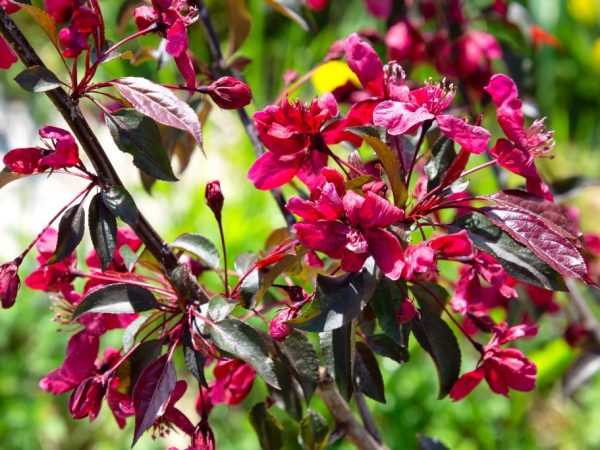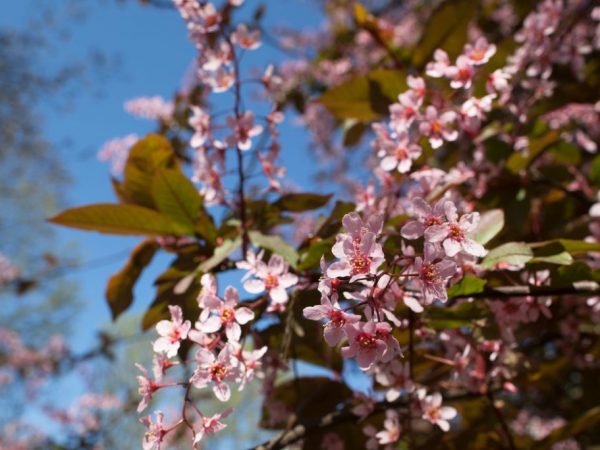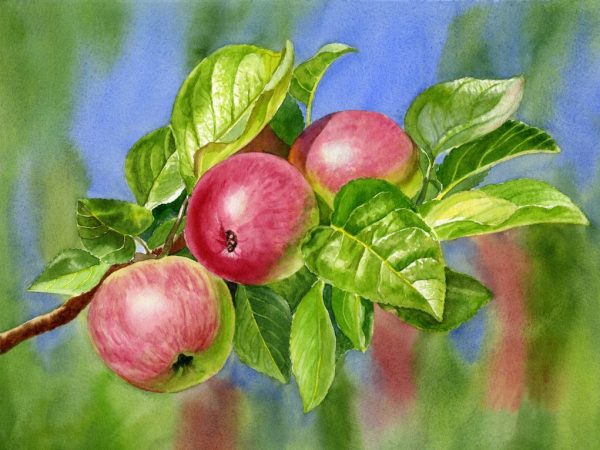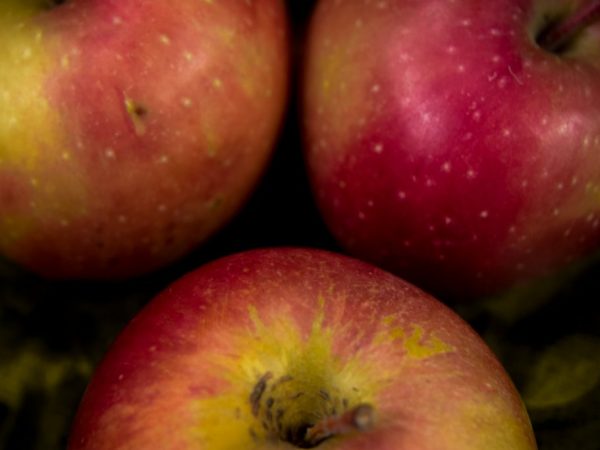Decorative Apple Royalty
The Royal apple tree is an ornamental tree. It is used to decorate gardens, parks and squares. It was bred on the basis of the Nedzetskiy variety growing in Central Asia. A distinctive feature is purple leaves and large red flowers. It grows slowly, the fruits are practically inedible.
- Description of the variety
- Dignity
- disadvantages
- Description of the tree and fruit
- Yield
- Pollination
- Frost resistance
- Disease and pest resistance
- Saplings price
- Use in landscape design
- In which regions are they grown
- Landing
- Landing dates
- Landing technology
- Care
- Watering
- Top dressing
- Pruning and shaping the crown
- Preparing for winter
- Reproduction
- Rejuvenation
- Disease and pest control
- Features of ripening and fruiting
- Harvesting and storage
- Varieties and subspecies
- Gardeners reviews

Decorative Apple Royalty
Description of the variety
Ornamental varieties of apple trees are popular among gardeners. They are often used by landscape designers to decorate park areas.
Royalty occupies one of the leading places among all varieties of this direction.
Dignity
- Resistant to frost and wind
- Drought tolerance
- Undemanding to soil quality
- Unpretentious care
- Good adaptation in any climate
- Beautiful appearance
disadvantages
- Slow growth
- Poor perception of pruning (further stunted growth)
- Inedible raw fruit
Description of the tree and fruit
The height of a tree at 10-12 years old reaches 3-4 m, the maximum is about 5-6 m. The crown has an oval or spherical shape, its diameter is 4-5 m.
If the crown is not trimmed, the contours become irregular.
Sometimes lateral shoots appear near the trunk, and the apple tree turns into a shrub. In weeping varieties, the branches hang down, practically do not require correction.
The growth of branches is small, up to 40-50 cm per year. At first they are located compactly in relation to the trunk, but then they become spreading. The bark on them is dark, smooth. The trunk is of medium thickness, flat.
The leaves are oval, elongated-ovate or elliptical, 8-12 cm long. The surface is smooth, glossy, with a slight edging.
The magenta or dark purple leaf plate is the main quality that gives the Royalties an original decorative look. At the end of summer, the tree brightens and becomes crimson red.
The leaves do not fall off for a long time and stand out against the background of the gray autumn landscape. If the crown is dense, the leaves on top may be dark green, which absolutely does not impair the appearance of the apple tree. In the wind, it shimmers in different shades.
Flowering begins in early May and lasts 2 weeks. In arid regions, it can be reduced to 4-5 days.
The buds sit on elongated, whitish peduncles with a felt edge. They are collected in inflorescences of 4-5 pieces, abundantly cover the branch. The flowers have a shade of ruby, carmine, red raspberry, tea rose. Their diameter is 2.5-3.5 cm.
Fruits are small, up to 2-3 cm, slightly elongated, dark red, abundantly covered with gray-blue waxy bloom.
Apples look like cherries. They are located on long, thin stalks and are in harmony with the purple autumn leaves of the tree.Some of the fruits stay on the branches until spring, decorating a sleeping winter garden.
Yield

Apples are rarely in demand
The ornamental royalty apple tree gives small fruits, they taste bitter-sour, many consider them inedible.
There have been cases of digestive upset after consuming them.
Experienced gardeners claim that they make delicious cider (apple wine), tinctures and even jam with compotes. They are mixed with other varieties to give the dishes an interesting and original flavor.
Pollination
In the Royalty apple tree, self-pollination is weak, only a small percentage of flowers turn into ovaries. Any varieties can be pollinators.
If the ornamental tree grows in the garden, it will have more apples. But little attention is paid to this nuance, because the fruits are rarely harvested.
Frost resistance
High resistance to frost. It can be planted in all regions, starting from the fourth zone.
This means that the variety does not die if the average annual values of the minimum temperatures are in the range from -31 ⁰ to -34 С.
Frost resistance increases with a high standing groundwater. Shoots on young trees may partially die or weaken if the frost is too severe in winter. Therefore, in the north, seedlings in the early years are recommended to be covered.
Disease and pest resistance
Royalty is moderately resistant to disease. The apple tree can be affected by scab or powdery mildew. A bacterial burn is not uncommon.
Pests also attack, but slightly less often than table varieties. The fruits are practically not affected by the apple moth.
Saplings price
The cost of seedlings primarily depends on age and height. It is higher if the roots are covered with a clod of earth or the tree is sold in a tub. Average prices for seedlings in containers (with closed root system):
- 30-40 cm - 600-800 rubles
- 50-80 cm - 1500-2800 rubles
- 1-1.2 m - 3500-6000 rubles
- 1.5-2 m - 5000-9000 rubles
Seedlings without containers (with closed or open roots):
- 150-200 cm - 1600-2800 rubles
- 200-250 cm - 3500-4100 rubles
Wholesale prices are 10-40% cheaper than retail prices. Most often, lots of more than 30-50 pieces are sold in bulk. Also, the cost is influenced by the level of the nursery in which the trees are grown. It is better not to save money, but to buy from trusted firms. Then there is a guarantee that they will really be varietal, they will take root on the site.
Use in landscape design
Beautiful trees with red leaves are often used in landscaping. They are planted in front of administrative buildings, along streets, in city parks and squares. Many create compositions on their personal plots or near private houses.
Trees grow short, but they have a beautiful wide crown. Therefore, it can become the center of the garden landscape around which the entire composition is built. Varieties with lowered weeping branches look especially beautiful in this regard.

The appearance of the apple tree is very beautiful
The Royalty variety easily transforms into a bushy form. You can build hedges from it. Low trees with purple leaves are planted along the roads, interspersed with poplars or maples. In such a combination, their unusual color is beautifully emphasized. In the spring, they begin to bloom, filling the entire city or summer cottage with a unique aroma.
In which regions are they grown
The ancestors of the Royalty variety came to Russia and European countries from Central Asia. But as a result of selection, they adapted well to a temperate and even cold climate - they can be seen in the gardens of the Moscow Region, the Leningrad Region, Siberia and the Urals.
They tolerate drought and winds well, therefore they are often planted in steppe regions with a harsh continental climate.
Landing
Apple Royalty is not demanding on the planting site and soil. It grows well in both sunny and shaded areas. Clay soils and loams with a moderate level of fertility are suitable for her.
Landing dates
Can be planted in spring and autumn.When planting in spring, you need to catch the moment when the earth has already warmed up, and the buds on the trees have not yet blossomed. In areas with a temperate climate - this is the end of March or early April, in the north - mid or late April, in the south - mid-March. At the same time, the pit is harvested before winter.
An autumn planting should be planned 2 months before the onset of frost. In the north, this is the end of August or the beginning of September, in the middle lane, mid-September or early October. In the southern regions, trees can be planted even before early November.
Landing technology
When choosing a place for landing, you should take into account the following points:
- If a tree grows in a dark place, its leaves change color from purple to dark green.
- If the shadow constantly falls on one side of the crown, it begins to grow disproportionately and deforms.
The distance between two trees depends on the purpose for which they are planted. To create a hedge or alley, they dig holes 3-5 m apart. Single apple trees should grow no closer than 15 m.
The depth of the pit is 40-50 cm, the diameter is about 80 cm. If the soil in the area is clay, and the groundwater is high, drainage from coarse river sand, pebbles or small expanded clay must be placed on one. You can also add fertile garden soil mixed with complex fertilizers, or a mixture of peat with humus.
A seedling with a clod of soil can be transferred to the site immediately. If the roots are bare, they are immersed in warm water with a growth stimulator for 4-5 hours. Before planting, the roots are carefully straightened and the tree is placed vertically in the hole. Sprinkle with earth so that the root collar is 2-3 cm above the surface.At the end, pour 5-8 liters of water.
If the seedling is small, and there is a cold winter ahead, it is advised to cover it with straw or special agricultural film. It's also a good idea to make mulch near the trunk. To do this, use high-moor peat mixed with lime, straw, small pebbles, turf. Preparation for winter begins in late October, when the tree will shed almost all of its foliage.
Care
Royalty is an unpretentious variety. But with good care, correct crown correction, its decorative qualities improve. Diseases and pests will not infect beautiful leaves, the apple tree will delight the eye.
Watering
Royalty does not need abundant watering. With excessive moisture, flowers and fruits can fall off, leaves change their shade and even roots rot. We must not forget that the variety comes from the eastern arid regions of Asia.
Watering is necessary in dry and hot summers, with a lack of precipitation in the spring (during the flowering period). Under one young apple tree, no more than a bucket of water is poured, under an adult tree - 2-3 buckets. So that moisture does not evaporate quickly, after watering the ground is loosened and covered with mulch.
Top dressing
The unpretentious Royalty variety does not need abundant feeding. Fertilizers are recommended to be applied no earlier than a year after planting. This is best done in the spring, just before flowering begins.
A complex mixture is introduced into the soil, specially designed for ornamental plants. The next time feeding is used only after a year. If the soil on which the Royalty grows is fertile, rich in nutrients and humus, it may not be fed at all.
Pruning and shaping the crown

Apple pruning does not affect yield
The Royalty does not tolerate pruning very well, the apple tree slows down its growth. Some gardeners recommend leaving the tree alone for the crown to form naturally. In modern landscape design, you still have to cut branches.
Most often, sanitary pruning is carried out in spring and autumn. Remove dry and damaged branches. When the tree is covered with foliage, you can carefully cut off the pagons that protrude beyond the dome and spoil the overall appearance.
Artistic shaping of the crown is contraindicated for this variety, it may stop growing or die altogether.
Preparing for winter
Young seedlings should be prepared for winter.In the northern regions, it is recommended to shelter adult trees. It is best to use a special synthetic film for this. If you don't have one at hand, you can use lapotnik, reed, straw. But under natural materials, rodents (mice and rats) are often found, which can damage the bark or completely destroy the apple tree.
To prevent the roots from freezing, mulch is made around the tree for the winter. It is recommended to make it from sawdust, tree bark or shavings. You can also use fine gravel, high moor peat. After a dry autumn, it is advised to water the apple tree, this increases the frost resistance of the roots.
Reproduction
In theory, Royalties can be propagated by apple seeds. But at the same time, there is a high probability that young trees will not retain their varietal qualities. And the process of growing seedlings will be too long.
The best breeding option is seedlings. You can cook them yourself. In autumn, young one-year pagons are chosen, 0.7-0.8 mm thick. Cut carefully along the oblique line. Then they are planted in the ground under a shelter or stored in the basement (in a box with sand) until spring.
At the end of February, cuttings can be rooted in water or a special substrate. They are also used as grafts on other apple varieties.
Rejuvenation
It happens that shoots on a tree slow down their growth, and young branches begin to die off. In this case, it is recommended to carry out its rejuvenation or radical pruning. This is done in early spring, until the buds begin to swell and juices have gone down the trunk.
Description of the procedure for rejuvenation:
- Side shoots are cut from above
- Below are weak branches growing upward.
- The general branches should always remain longer than their branches.
- Large knots in the lower part of the trunk do not touch; after pruning, they can provoke the formation of hollows and the death of the tree.
- After the completion of the procedure, the places of the cuts are covered with garden pitch.
To further stimulate growth, potash-phosphorus fertilizers or wood ash are added.
Disease and pest control
The Royalty variety can be attacked by insect pests and is often attacked by fungi and bacteria. To prevent diseases such as scab, powdery mildew, brown spot, trees in the garden are treated with fungicides. To prevent insect infestation, apple trees are sprayed with insecticides.
Processing is carried out three times a year:
- In March, before bud break
- In May, during flowering
- Late September or early October, before the leaves fall
Instead of industrial chemicals, you can use Bordeaux liquid or copper sulfate, they are not so toxic. In late autumn, be sure to remove all the leaves from the garden. Fungi and insect larvae reproduce well in them, and in the spring they infect trees.
Features of ripening and fruiting
Fruiting later. The first fruits appear 5-6 years after planting. Flowering begins in early May, lasts from 4 to 14 days, depending on the region. The peculiarity of this variety is that the flowers do not bloom at the same time. Large buds and delicate red flowers can be seen on the tree.
Fruits begin to form immediately after the petals fall. They also do not grow and ripen at the same time. The first red apples appear at the end of August, and the last - in the third decade of September. They can hang on branches even after the leaves have fallen, right up to the first severe frost and snow.
Ripe apples resemble oval cherries. They attach to the branches with elongated stalks. The skin is dark red, covered with bloom on top. The size of the apples is small, about 2-3 cm in diameter, they weigh no more than 30-40 g.
Harvesting and storage
Most gardeners do not pick Royalties apples. consider them inedible. According to the description, the fruit contains many organic acids and triterpenoids. This gives them a specific sour and tart taste, with a pronounced bitterness.
Concentrated organic acids can break down the stomach lining, causing symptoms similar to poisoning.
Young children are especially sensitive to them. Intoxication can occur if you eat apples from a tree that was previously treated with chemicals from fungi or pests.
Some cooks successfully use small Royal apples in the kitchen. You can make jams from them. It is best to add fruits in small quantities to other varieties, be sure to cook in concentrated syrup with a lot of sugar.
Letting the apples ferment with sugar makes a great cider. They are also poured with vodka or alcohol, making a bitter apple tincture. It is not recommended to keep fresh, they quickly lose their qualities, rot or dry out.
Varieties and subspecies
There are several subspecies of the Royal apple tree. They differ in size and shape of the crown, height.
- Royalty pendula or Malus Royalty pendula. The shape of the crown is columnar, the branches hang down like a weeping willow. The leaves are not purple, but a dark green tint with a slight admixture of purple. The flowers are pink, not dark red.
- Hybrid purple, Royalty Red or Malus hybridus purpurea. Differs in bright crimson foliage, abundant flowering of a pink-red hue.
- Royalty Beauty or Royal Beauty. Weeping variety, all branches of which are directed downward almost from the trunk itself. The leaves are purple, the flowers are purple-red.
In addition to the shape of the branches, the shade of flowers and foliage, the varieties are almost the same. They are winter hardy, suitable for growing in any region. Apples are inedible raw, but can be used for making alcoholic beverages, jams. Care and planting system are the same for all species.
Gardeners reviews
Most of the gardeners who grow the Royal variety celebrate its decorative qualities. The tree becomes a real decoration of the yard. In summer it pleases the eye with its original color of foliage, in spring - with abundant flowering. Crimson autumn leaves stay on the apple tree longer than on other species. It remains a bright spot among the gray garden until almost mid-November.
Fruits cannot be eaten raw. They are used to make jams, cider and tinctures. Although most people think that these apples are generally not suitable for eating.
Everyone notes the fact that the tree is unpretentious and practically does not require pruning to form the crown. For those who understand a thing or two about garden design, this is of great importance.
Royalties can be grown in the Moscow region, in the Urals and even in Siberia. But it is advised in the early years to cover the seedlings for the winter so that the young shoots do not freeze.

